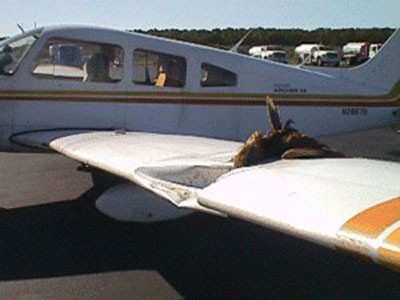Sat, Aug 25, 2012
Airports Are Required To Create And Implement Plans To Minimize Wildlife Hazards
In a report released Wednesday, the DOT's Inspector General found that FAA’s oversight and enforcement activities of its Wildlife Hazard Mitigation Program are not sufficient to ensure airports fully adhere to Program requirements or effectively implement their wildlife hazard plans. Under the Program, FAA requires airports to create and implement wildlife hazard management plans to assess and minimize the risk of future strikes.

"(The) FAA has not developed robust inspection practices, and its inspectors do not have the technical expertise to effectively oversee the Program," the report says. "Inspectors we spoke with mostly relied on interviews with airport personnel to determine compliance with regulatory requirements, rather than reviewing strike and airport records. Also, inspectors were not maintaining adequate records of their inspection activities."
The FAA’s policies and guidance for monitoring, reporting, and mitigating wildlife hazards are mostly voluntary, thereby limiting their effectiveness. For example, FAA recommends but does not mandate that airports and aircraft operators report all wildlife strikes to FAA’s strike database. As a result, FAA’s strike data are incomplete, which impacts the Agency’s ability to evaluate the effectiveness of its Program in reducing wildlife hazards. Finally, FAA coordinates effectively with the U.S. Department of Agriculture Wildlife Services, its main partner in wildlife hazard mitigation, but its efforts to coordinate with other relevant Government agencies are limited and infrequent.
The IG made 10 recommendations intended to improve FAA’s management and oversight of the Program. In its response, the FAA concurred with six, partially concurred with three, and did not concur with one. The IG said it is requesting additional information or revised responses for five recommendations—particularly related to improving the quality and quantity of the Agency’s wildlife strike data.

More News
Aero Linx: Model Aeronautical Association of Australia MAAA clubs are about fun flying, camaraderie and community. For over 75 years, the MAAA has been Australia’s largest fl>[...]
Touchdown Zone Lighting Two rows of transverse light bars located symmetrically about the runway centerline normally at 100 foot intervals. The basic system extends 3,000 feet alon>[...]
“Discovery and innovation are central to our mission at Virgin Galactic. We’re excited to build on our successful record of facilitating scientific experiments in subor>[...]
How To Get A Story On Aero-TV News/Feature Programming How do I submit a story idea or lead to Aero-TV? If you would like to submit a story idea or lead, please contact Jim Campbel>[...]
Student Pilot Reported That During Rotation, “All Of A Sudden The Back Of The Plane Kicked To The Right..." Analysis: The student pilot reported that during rotation, “>[...]
 ANN's Daily Aero-Linx (05.02.24)
ANN's Daily Aero-Linx (05.02.24) ANN's Daily Aero-Term (05.02.24): Touchdown Zone Lighting
ANN's Daily Aero-Term (05.02.24): Touchdown Zone Lighting Aero-News: Quote of the Day (05.02.24)
Aero-News: Quote of the Day (05.02.24) ANN FAQ: Contributing To Aero-TV
ANN FAQ: Contributing To Aero-TV NTSB Final Report: Cirrus Design Corp SR20
NTSB Final Report: Cirrus Design Corp SR20




